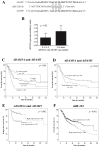Association of Inherited Copy Number Variation in ADAM3A and ADAM5 Pseudogenes with Oropharynx Cancer Risk and Outcome
- PMID: 36553675
- PMCID: PMC9778539
- DOI: 10.3390/genes13122408
Association of Inherited Copy Number Variation in ADAM3A and ADAM5 Pseudogenes with Oropharynx Cancer Risk and Outcome
Abstract
Inherited copy number variations (CNVs) can provide valuable information for cancer susceptibility and prognosis. However, their association with oropharynx squamous cell carcinoma (OPSCC) is still poorly studied. Using microarrays analysis, we identified three inherited CNVs associated with OPSCC risk, of which one was validated in 152 OPSCC patients and 155 controls and related to pseudogene-microRNA-mRNA interaction. Individuals with three or more copies of ADAM3A and ADAM5 pseudogenes (8p11.22 chromosome region) were under 6.49-fold increased risk of OPSCC. ADAM5 shared a highly homologous sequence with the ADAM9 3'-UTR, predicted to be a binding site for miR-122b-5p. Individuals carrying more than three copies of ADAM3A and ADAM5 presented higher ADAM9 expression levels. Moreover, patients with total deletion or one copy of pseudogenes and with higher expression of miR-122b-5p presented worse prognoses. Our data suggest, for the first time, that ADAM3A and ADAM5 pseudogene-inherited CNV could modulate OPSCC occurrence and prognosis, possibly through the interaction of ADAM5 pseudogene transcript, miR-122b-5p, and ADAM9.
Keywords: ADAM3A; ADAM5; copy number variation; microRNA; oropharynx squamous cell carcinoma; pseudogene.
Conflict of interest statement
The authors declare no conflict of interest.
Figures

Similar articles
-
ADAM3A copy number gains occur in a subset of conjunctival squamous cell carcinoma and its high grade precursors.Hum Pathol. 2019 Dec;94:92-97. doi: 10.1016/j.humpath.2019.08.020. Epub 2019 Sep 5. Hum Pathol. 2019. PMID: 31493427 Free PMC article.
-
N6-methyladenosine-associated prognostic pseudogenes contribute to predicting immunotherapy benefits and therapeutic agents in head and neck squamous cell carcinoma.Theranostics. 2022 Oct 17;12(17):7267-7288. doi: 10.7150/thno.76689. eCollection 2022. Theranostics. 2022. PMID: 36438489 Free PMC article.
-
Role of a genetic variation in the microRNA-4421 binding site of ERP29 regarding risk of oropharynx cancer and prognosis.Sci Rep. 2020 Oct 12;10(1):17039. doi: 10.1038/s41598-020-73675-z. Sci Rep. 2020. PMID: 33046743 Free PMC article.
-
Pseudogene Transcripts in Head and Neck Cancer: Literature Review and In Silico Analysis.Genes (Basel). 2021 Aug 17;12(8):1254. doi: 10.3390/genes12081254. Genes (Basel). 2021. PMID: 34440428 Free PMC article. Review.
-
Association Between Mitochondrial DNA Copy Number and Head and Neck Squamous Cell Carcinoma: A Systematic Review and Dose-Response Meta-Analysis.Med Sci Monit. 2021 Jan 20;27:e928327. doi: 10.12659/MSM.928327. Med Sci Monit. 2021. PMID: 33468984 Free PMC article.
Cited by
-
The gene signature linked to lactate metabolism predicts the prognosis and correlates with the immune status of head and neck squamous cell carcinoma.Front Genet. 2025 Apr 4;16:1540841. doi: 10.3389/fgene.2025.1540841. eCollection 2025. Front Genet. 2025. PMID: 40255484 Free PMC article.
-
Pseudogenes in Cancer: State of the Art.Cancers (Basel). 2023 Aug 8;15(16):4024. doi: 10.3390/cancers15164024. Cancers (Basel). 2023. PMID: 37627052 Free PMC article. Review.
-
The impact of ERP29 on the progression of pharyngeal squamous cell carcinoma.Sci Rep. 2024 Oct 27;14(1):25681. doi: 10.1038/s41598-024-76210-6. Sci Rep. 2024. PMID: 39465248 Free PMC article.
-
Identifying the prognosis implication, immunotherapy response prediction value, and potential targeted compound inhibitors of integrin subunit α3 (ITGA3) in human cancers.Heliyon. 2024 Jan 6;10(2):e24236. doi: 10.1016/j.heliyon.2024.e24236. eCollection 2024 Jan 30. Heliyon. 2024. PMID: 38293430 Free PMC article.
-
Competing endogenous RNAs network dysregulation in oral cancer: a multifaceted perspective on crosstalk and competition.Cancer Cell Int. 2024 Dec 26;24(1):431. doi: 10.1186/s12935-024-03580-2. Cancer Cell Int. 2024. PMID: 39725978 Free PMC article. Review.
References
-
- Carron J., Costa A.P.D., Rinck-Junior J.A., Mariano F.V., Carvalho B.S., Lima C.S.P., Lourenço G.J. Role of a genetic variation in the microRNA-4421 binding site of ERP29 regarding risk of oropharynx cancer and prognosis. Sci. Rep. 2020;10:17039. doi: 10.1038/s41598-020-73675-z. - DOI - PMC - PubMed
Publication types
MeSH terms
Substances
LinkOut - more resources
Full Text Sources
Medical
Molecular Biology Databases
Miscellaneous

